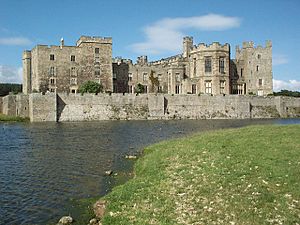Henry Vane, 1st Earl of Darlington facts for kids
Quick facts for kids
Henry Vane, 1st Earl of Darlington
PC
|
|
|---|---|

Arms of Vane: Azure, three sinister gauntlets (appaumée) or These are a difference of the arms of the Fane family, Earls of Westmorland from 1624, which show: three dexter gauntlets back affrontée, with identical tinctures
|
|
| Member of the Great Britain Parliament for Launceston |
|
| In office 1726–1727 Serving with John Freind
|
|
| Preceded by |
|
| Succeeded by |
|
| Member of the Great Britain Parliament for St Mawes |
|
| In office 1727–1741 Serving with
|
|
| Preceded by |
|
| Succeeded by |
|
| Member of the Great Britain Parliament for Ripon |
|
| In office 1741–1747 Serving with William Aislabie
|
|
| Preceded by |
|
| Succeeded by |
|
| Member of the Great Britain Parliament for County Durham |
|
| In office 1747–1753 Serving with George Bowes
|
|
| Preceded by |
|
| Succeeded by |
|
| Personal details | |
| Born | c. 1705 |
| Died | 6 March 1758 |
| Political party | Whig |
| Spouse | Lady Grace Fitzroy |
| Children |
|
Henry Vane, 1st Earl of Darlington, PC (around 1705 – 6 March 1758), was an important British politician. He was known as Lord Barnard between 1753 and 1754. He served in the House of Commons, which is a part of the British Parliament, from 1726 until 1753. After that, he became a peer as Baron Barnard.
Early Life and Family
Henry Vane was born around 1705. He was the oldest son of Gilbert Vane, 2nd Baron Barnard. His family lived at Raby Castle in Staindrop, County Durham, England. His mother was Mary Randyll.
In 1725, Henry Vane married Lady Grace Fitzroy. She was the daughter of Charles Fitzroy, 2nd Duke of Cleveland.
Political Career
Henry Vane first tried to become a Member of Parliament (MP) for County Durham in 1722. He was part of the Whig political group. However, he did not win that election.
In 1726, he was elected as an MP for Launceston. The government helped him get this seat. In 1727, he planned to run for County Durham again. But he stepped aside to help the Whig party win. Instead, he became an MP for St Mawes without anyone running against him.
Later, Henry Vane joined the political opposition. This meant he disagreed with the government in power. He became close to William Pulteney, 1st Earl of Bath. He was re-elected for St Mawes in 1734. In 1741, he was elected without opposition for Ripon.
Later Political Roles
After the Prime Minister, Robert Walpole, left office in 1742, Henry Vane received an important job. He became the Vice-Treasurer and Paymaster General of Ireland. He also joined the Privy Council in Ireland. This council advises the monarch.
However, he lost his Irish job in 1744. In 1747, he was finally elected as an MP for County Durham. This time, he supported the government. He became a close supporter of the Duke of Newcastle. In 1749, he was appointed a Lord of the Treasury. This was an important role in managing the country's money. He held this position until 1755.
In 1753, his father passed away. Henry Vane then became the 3rd Baron Barnard. He also became the Lord Lieutenant of Durham, a royal representative for the county, from 1753 to 1758. In 1754, he was given even higher titles by the Duke of Newcastle. He became the 1st Earl of Darlington and the 1st Viscount Barnard. From 1755 to 1756, he also served as the Joint Paymaster of the Forces. This role involved managing payments for the military.
Death and Legacy
Henry Vane, 1st Earl of Darlington, passed away on 6 March 1758. His son, Henry Vane, 2nd Earl of Darlington, took over his titles.
Henry and his wife, Grace, had seven children:
- Lady Mary Vane
- Henry Vane, 2nd Earl of Darlington (1726–1792)
- Lady Anne Vane, who was a botanist (1726–1776)
- Hon. Frederick Vane (born 1732)
- Hon. Charles Vane
- Hon. Raby Vane (1736–1769)
- Lady Harriet Vane (1739–1759)


